

Seeking an Oasis in a Food Desert: How Residents Shaped Savannah, Georgia's Approach to Making Healthy Foods Accessible
Article highlights
.@CityofSavannah participated in @BHcityleaders' Innovation Track to develop solutions to pressing problems while adopting #innovation techniques. Read about the city's approach to making healthy food accessible
Share article"If we really want to prioritize equity, this is going to be one of our best & biggest chances to be able to do that. If you're able to have healthy people, you're able to change outcomes." @MayorJohnsonSAV
Share articleCould a small grocery store designation & healthy vending machines help to address the westside food desert in @CityofSavannah? Through @BHcityleaders' Innovation Track, the team engaged with residents in new ways
Share articlePartnering for Learning
We put our vision for government into practice through learning partner projects that align with our values and help reimagine government so that it works for everyone.
From November 2020 to August 2021, Savannah, Georgia, participated in the Bloomberg Harvard Innovation Track, a Bloomberg Harvard City Leadership Initiative program delivered in partnership with the Centre for Public Impact. During the program, 11 interdisciplinary city teams from across the U.S. developed innovative solutions to a pressing city problem while adopting cutting-edge innovation techniques that engage residents in testing, adapting, and scaling ideas with the potential for long-term impact.
In Savannah, the team participating in the Bloomberg Harvard Innovation Track focused on improving access to healthy foods in communities without a grocery store within a mile, specifically on the city's westside. We set a goal to ensure food selection was no longer a choice between convenience, quality, price, and proximity, which perpetuates social and health-based inequities.
We wanted our solutions to:
Make healthy foods more accessible and closer in proximity, meaning less than a mile away and safe and easy for residents to access,
Create a healthier population with fewer diet-related health conditions,
Allow residents to spend a smaller proportion of income on healthy foods, and
Shrink or eradicate food deserts in Savannah.
History and context of Savannah
Savannah's westside has a rich and diverse history. Located less than 3 miles from City Hall in downtown Savannah, the West Savannah neighborhood is one of several communities on the city's westside. The land belonged to the Yamacraw tribe in the 1700s, operated as a rice plantation in the early 1800s, and was home to the largest sale of enslaved people in U.S. history in 1859, now known as The Weeping Time. With the end of slavery and the plantation era after the Civil War, western Savannah was still largely farmland, forested in some places, crisscrossed here and there by railroad tracks. As the nineteenth century slid into the twentieth, developers began to purchase land and layout subdivisions.
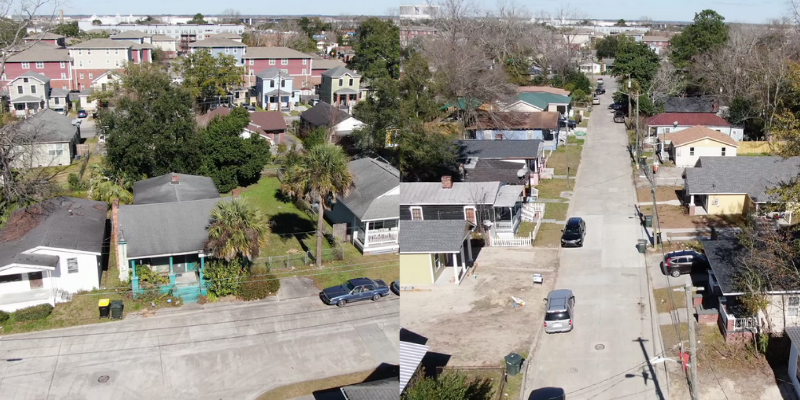 Residential streets in West Savannah
Residential streets in West Savannah
By the early 1900s, neighborhood small businesses provided needed goods to West Savannah residents who couldn't or didn't want to travel downtown to shop or preferred to buy from their friends and neighbors. These included locally-owned grocery stores and fresh produce stands strategically placed along main roads.
In 1933, President Franklin D. Roosevelt established the Home Owners' Loan Corporation Act, which created the Home Owners' Loan Corporation (HOLC). The HOLC was a government-sponsored entity designed to prevent foreclosure for homeowners currently in default and expand home purchase opportunities. The HOLC's "residential security maps" were intended to evaluate mortgage risk. Neighborhoods deemed "hazardous" were marked red. These locations were denied access to investment that could help improve housing stock and economic opportunity for residents. In historic West Savannah, the HOLC graded a portion of the area "B: Still Desirable." Despite this, the HOLC stated the homes in the area were in poor repair and recommended that no new construction take place in the area.
On July 29, 1960, the City of Savannah adopted its first-ever zoning ordinance, regulating development and land use. West Savannah had an established residential development pattern. Most parcels were designated Four Family Residential (R-4), and this zoning district prohibited using land for a grocery. In July 1960, a modern chain store called Foodtown moved into the neighborhood across West Bay Street, giving those living on the westside an additional option for grocery shopping. However, as integration and the Civil Rights Movement advanced, Black Savannahians throughout the city exercised their rights to shop wherever they chose. As a result, neighborhood businesses that had cultivated an African American clientele lost out to downtown or southside stores. Also, the flight of white homeowners from western Savannah caused businesses to lose both customers and proprietors.
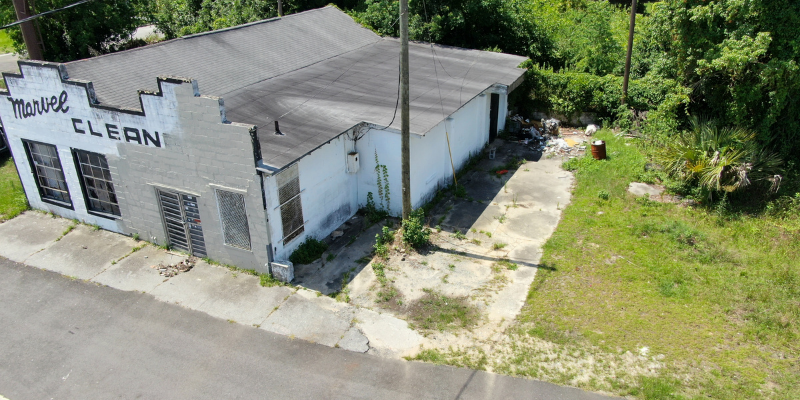 The former Marvel Cleaners building now sits vacant along West Bay Street in West Savannah
The former Marvel Cleaners building now sits vacant along West Bay Street in West Savannah
Over the next decades, westside residents and neighborhood associations advocated to fill this gap. They attempted to bring a grocery store to the area for years but were repeatedly told by large retailers their neighborhood doesn't meet density or spending requirements to open. Finally, in 2016, these grassroots efforts, coupled with a partnership with a developer local to West Savannah, brought the reality of a store closer than ever before. With a portion of the initial capital investment promised and independent market research conducted, a grocery chain sent representatives to Savannah to pitch a plan for a store to residents and city leaders.
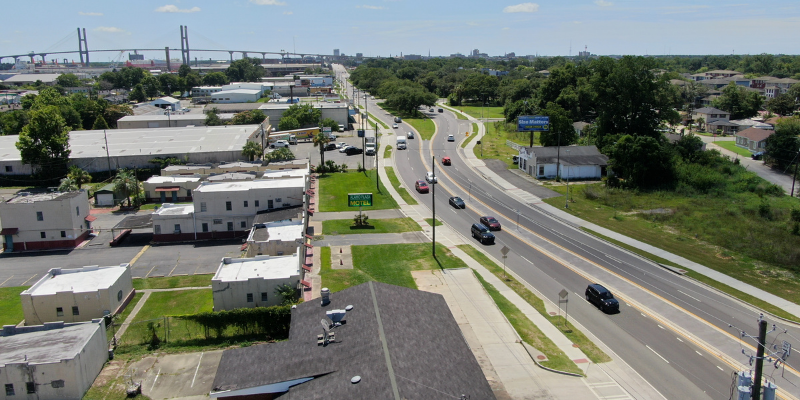 West Bay Street is a major thoroughfare and commercial business corridor in West Savannah
West Bay Street is a major thoroughfare and commercial business corridor in West Savannah
"In 2016, we had this opportunity," said Savannah Mayor Van R. Johnson, II, who was the district alderman for West Savannah at the time. "We actually had a grocer identified. They, being a smaller grocer, wanted to do something to better this community. Some residents, led by people with other political interests, objected to the interested company, bucked up against it. Here we are five years later, and we still don't have a grocery store. People are tired of hearing promises that things are going to get better and seeing that their life doesn't change any."
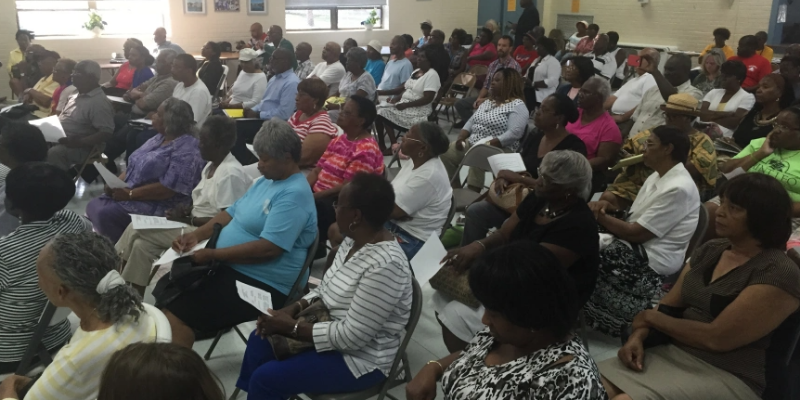 The 2016 community meeting focused on bringing a grocery store to West Savannah
The 2016 community meeting focused on bringing a grocery store to West Savannah
Seven places to buy liquor, none to buy produce
After the failed attempt to build a grocery store in 2016, westside residents were left without a place to buy fresh foods - an area of food apartheid that persists today. One resident explained there are six or seven places she can buy alcohol, and nowhere she can buy fresh produce. Corner and convenience stores sometimes offer a few fruits or vegetables, often stored in a box for highly-processed food and placed near the register. The perpetual lack of investment to improve food access, coupled with the failed 2016 plan for the grocery store, created doubt for many residents that the city could or would prioritize a permanent solution.
"This is the equity issue of our day," Mayor Johnson said. "If we really want to prioritize equity, this is going to be one of our best and biggest chances to be able to do that. If you're able to have healthy people, you're able to change outcomes. When you have kids who have diabetes and high blood pressure at 12 years old, that's a problem."
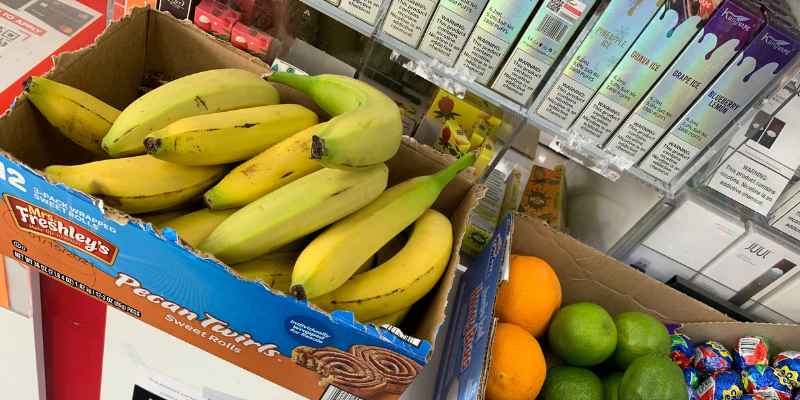 Produce selection at a West Savannah convenience store
Produce selection at a West Savannah convenience store
Rebuilding trust to resolve a decades-long challenge
In November 2020, Savannah participated in the Bloomberg Harvard City Leadership Initiative Innovation Track and decided to use this opportunity to tackle this equity issue by addressing the westside food desert. The Innovation Track allowed us to engage with residents in new ways. At the beginning of the program, our team thought building a grocery store was the obvious solution to provide fresh, quality foods to our city's westside. However, through our experience in the Innovation Track, we learned a grocery store is just one component of a larger portfolio of solutions needed to get healthy foods in people's hands.
To dig deeply into the problem and develop potential solutions, we went directly to those living and working in West Savannah. Resident outreach to those closest to the problem, not just those who often engage with the city, was a challenge but well worth the extra effort to gain new insights. Building trust with residents was a key component in having honest conversations about previous and current issues and how to solve them. Willie Mae Knight, a community outreach coordinator for the city and West Savannah native, was an invaluable resource to help our team make those connections.
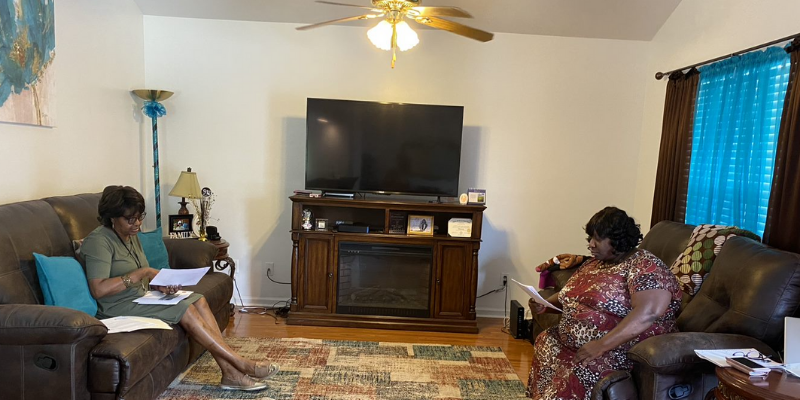 Willie Mae Knight conducts a resident prototype test during the Innovation Track
Willie Mae Knight conducts a resident prototype test during the Innovation Track
Willie Mae regularly works with Savannah's westside neighborhoods, so she was a familiar name and face to community leaders. She was also able to share personal stories about shopping in West Savannah's family-owned groceries as a child and memories of growing up in the community with residents. These personal stories helped Willie Mae build trust with residents, which also laid the foundation for trust with the rest of our team. By listening to residents' ideas, showing empathy with their experiences, and being honest about the purpose of the Innovation Track and its potential outcomes, we were able to co-design solutions with residents that went beyond the city's initial instinct to build a grocery store alone.
Solution one: small grocery store designation
After conducting substantive research and data externalization at the beginning of the Innovation Track, the team reframed the problem and built design criteria to develop solutions. Insights gained from the first round of stakeholder interviews taught us that proximity and access are not the same things. For example, one stakeholder stated any future store should be located on the same side of West Bay Street as Sustainable Fellwood, one of Savannah's most recent affordable housing developments.
We used "How might we…" questions to zoom into one key element of the problem: land use. The team investigated the question, "How might we envision and implement socially equitable land-use regulations that eradicate food deserts?" This led Candra Teshome, senior planner in the city's Planning and Urban Design Department, to complete a land-use analysis of West Savannah to determine if past land-use designations or policies interfered with food access. The analysis found that most parcels in West Savannah are zoned for single-family residential dwelling units only. Grocers are not allowed in this zoning district. The team agreed the small grocer designation was worth exploring.
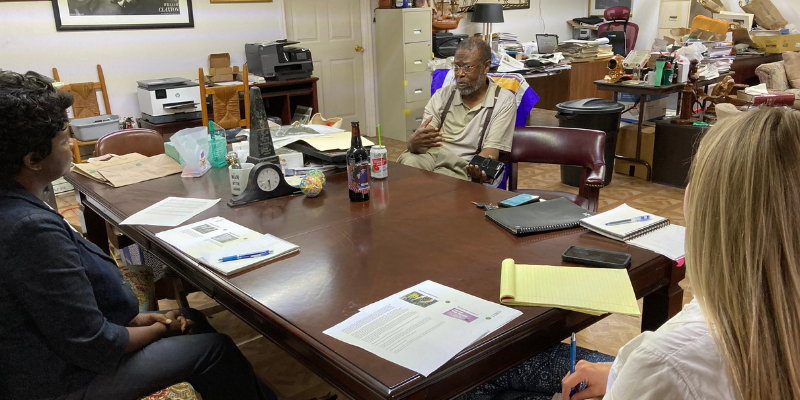 Candra Teshome and Amanda LaBrot conduct a prototype test with a local developer
Candra Teshome and Amanda LaBrot conduct a prototype test with a local developer
We also prompted residents to build their ideal store based on features they most wanted, such as food item choices and security. We asked them to add anything we didn't include, which surfaced details like automatic doors to make shopping with strollers and small children more manageable. We also found that residents don't necessarily prefer a big-box grocer. Instead, we heard them say they want convenient access to quality goods at competitive prices in a safe environment.
These insights contributed to the creation of a second set of criteria to explore the most important factors a small grocer or entrepreneur might need to set up a store and sustain operations, like tax incentives. We found that delivering incentives, whether they are incentives that support capital expenditures or operational expenditures, would make opening and maintaining a store a more attractive business venture. This was an important distinction because we were very aware that opening a store is one thing, and keeping it open is an entirely different challenge.
From these discussions, our team developed a small grocer designation to explore land-use regulations and the creation of business incentives to support the continued operation of future grocers in West Savannah. We believe that a small grocer zoning designation as an accessory use with design standards is a long-term solution that addresses land-use challenges and concerns regarding business sustainability. In addition, from an urban design perspective, establishing design standards respects the existing housing stock and historic development pattern.
Solution two: healthy vending machines
The other key stakeholders involved in shaping our team's ideas to improve food access were current convenience and corner store owners. While building a new grocery store on the westside is a priority, our team wanted to leverage the existing small business infrastructure in the community to supplement any future store. These smaller stores are already embedded throughout the neighborhood and could provide a closer place to grab fresh foods, if they're offered, beyond a grocery store.
The team presented several ideas to the business owners, like adding stops for the city's Forsyth Farmer's Market fresh produce food truck, to supplement their limited fresh food options. To the city team's surprise, owners overwhelmingly agreed to one idea in particular: a fresh food vending machine. Owners felt that machines offering healthy options like whole fresh produce, salads kits, and grab-and-go fruit and veggie cups would be a welcome addition to their stores.
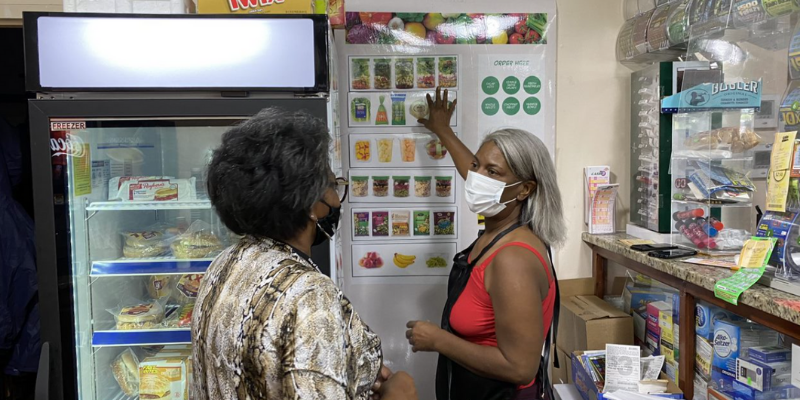 Rendering of the team’s vending machine prototype. We printed and brought to area convenience stores to test this idea with residents.
Rendering of the team’s vending machine prototype. We printed and brought to area convenience stores to test this idea with residents.
Possibly more surprising than the owners' reaction was the positive resident response to the healthy vending machines. We initially assumed residents would think we were presenting vending machines as an inequitable replacement for a grocery store. However, nearly everyone we surveyed said they would not only use them but also wanted them installed in community centers, parks, and gyms, in addition to corner stores. We tested the vending machine prototype with more than 60 residents ranging in age from 16 to 80 years old. Ninety-nine percent of respondents said they would use the machine if available to them.
Lessons from the Innovation Track
The Innovation Track taught us not to jump to conclusions or create solutions before thoroughly understanding a problem from the perspective of those closest to it. After talking to residents to get a good understanding of what it's like to live in an area without easily accessible healthy foods, we came up with several ideas ranging from practical to bold. It was through additional engagement with residents that we learned which of these ideas could become a true solution and what technical details had to be addressed for the solution to succeed.
 Residents interact with the healthy vending machine prototype
Residents interact with the healthy vending machine prototype
For example, while we thought a grocery store would be the solution, we learned that residents would also like additional options for grabbing healthy food that a vending machine could address. Had we not engaged with residents, our team likely would have dismissed this solution. But this experience taught us to challenge our assumptions by testing them with residents.
We also learned specific items residents wanted inside and outside of any future store, including well-maintained sidewalks, public transportation access, and smaller square footage with the promise of quality goods.
Our team is currently refining our portfolio of ideas, implementation plans, and target metrics for measuring success. We hope to discuss our proposals with our city council in the next few months and begin implementation in 2022. On a larger scale, we hope to be change agents within our respective departments to implement the resident-engagement practices, including relationship and trust-building techniques, learned through the Innovation Track to work across the city.
You may also be interested in...


Preventing residents from falling off the 'eviction cliff' in San José: Interviews with Guadalupe Gonzalez and Fred Tran on their TOPcities sprint
